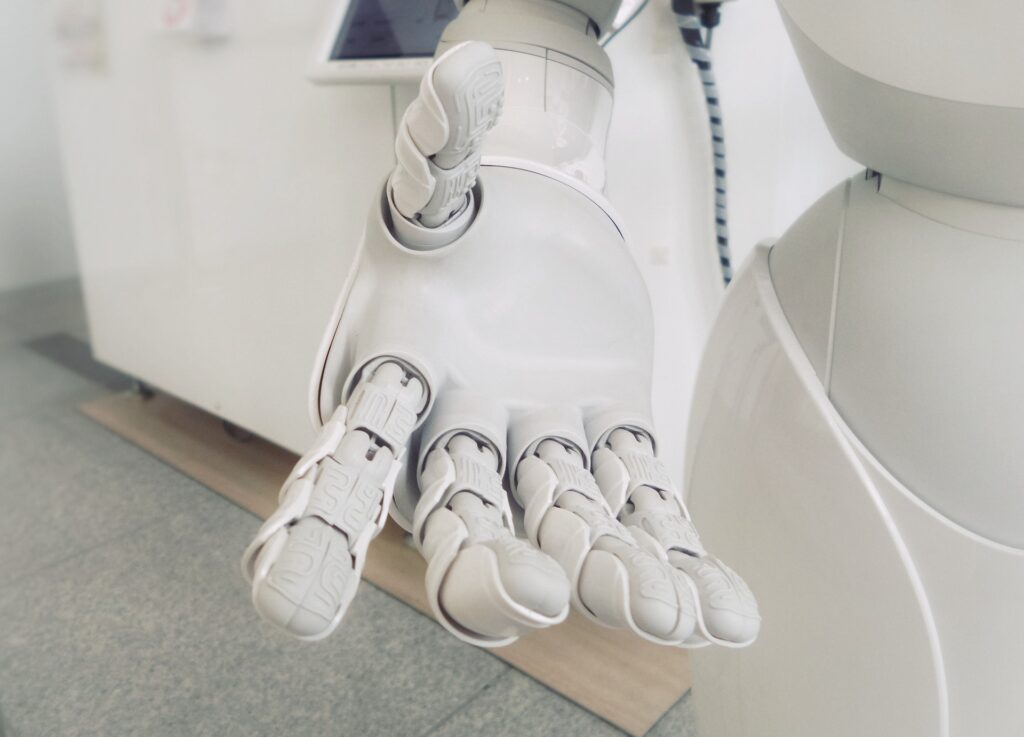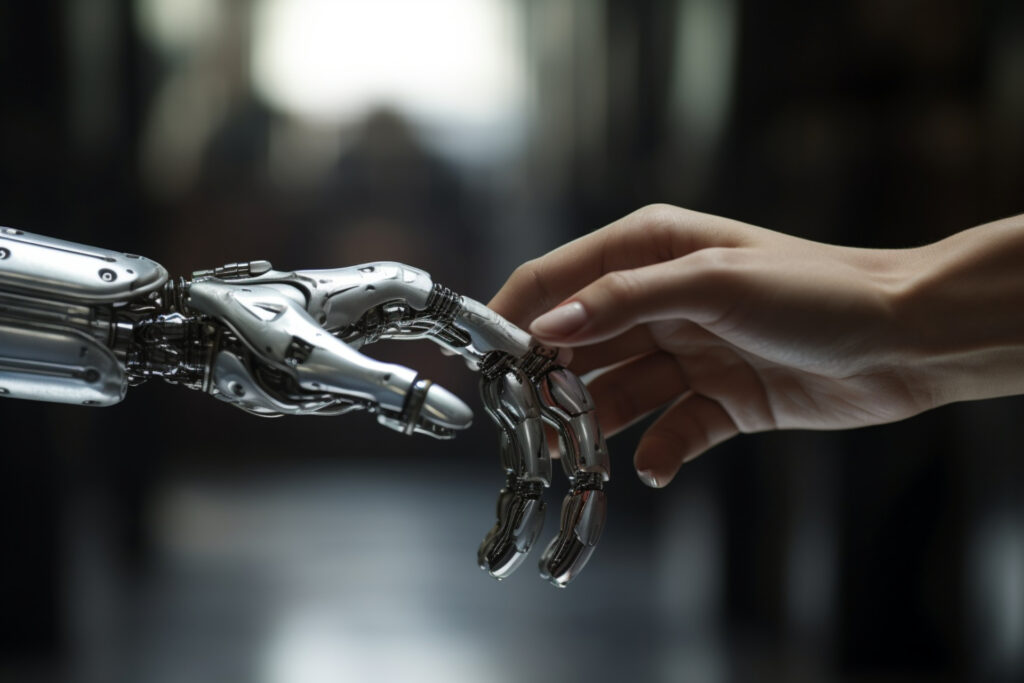Role of AI in HR: A Complete Guide
June 1st, 2023

Conversations about Artificial Intelligence (AI) are more intense than ever. Tools like ChatGPT are already transforming some industries and offering many different possibilities to improve and optimise tasks at work.
AI has been used to drive innovation, efficiency, and strategic decision-making in every sector, and Human Resources departments are no exception. The integration of AI into HR practices holds the promise of revolutionising talent management, recruitment, employee engagement and performance evaluation processes. By automating administrative and bureaucratic tasks, HR departments can focus on what really matters: people.
However, as there are many advantages to using AI in HR, there are also challenges to consider. To avoid the risks and dangers of AI, it is important to understand it further and pay attention to the ways in which it can help and the ways in which it can be a problem.
In this article, we’ll discuss what AI is, how it can be used in HR and what businesses should consider when implementing Artificial Intelligence into their routines. By understanding the complexities and implications of AI in HR, organisations can harness its power while upholding fairness and empathy.
What is Artificial Intelligence?
Before we look at how AI can be used in HR, it is worth understanding what Artificial Intelligence is and what is available to businesses and individuals.
Artificial Intelligence refers to the field of computer science focused on creating machines that can perform tasks that typically require human intelligence. For example, understanding language, recognising objects, learning from experience, and more.
There are several different types of AI models available, each with its own characteristics and applications. The field is constantly evolving, and choosing which AI model is best suited for your tasks depends on the available data, computational resources and what activities you need help with.
Here are some of the most common AI models:
Rule-based systems
These models use a set of predefined rules to make decisions or take action.
Rule-based systems follow a logical flowchart-like structure, reaching a conclusion based on “if-then” statements. They can be used to make deductions. For example, they can help a doctor reach a diagnosis based on a list of symptoms or help executives make a decision based on a set of information.
Machine learning (ML)
ML models learn from data and improve their performance over time. They analyse patterns and relationships to make predictions or take action.
Machine learning models are divided into three subtypes:
1. Supervised learning
The model is trained on labelled data, in which input data is paired with corresponding output labels.
This model learns to generalise from the training examples to make predictions; For example, it can be used to predict house prices based on location, features or other parameters.
2. Unsupervised learning
Different from supervised learning, this model works with unlabelled data. From there, it finds patterns, similarities or structures that help reach conclusions.
For example, when analysing data from sales, a company might use unsupervised machine learning to identify what products are more likely to please customers or what is the best time of year to display certain items.
3. Reinforcement learning
This type of ML involves an agent interacting with an environment and learning through trial and error. The agent receives feedback in the form of rewards or penalties based on its actions.
You can find examples of reinforcement learning in games or activities that provide a prize based on a series of accomplishments.
Deep learning
Deep learning models are a subset of ML models that use artificial neural networks inspired by the human brain. These networks consist of multiple layers of interconnected nodes that process and transform data.
These models are often used to recognise speech, perform natural language processing tasks and recognise complex patterns.
Natural language processing (NPL)
NPL models focus on understanding and processing human language. They enable machines to interpret and generate texts in the way a person would. As a result, it can perform text classification, sentiment analysis, machine translation, or chatbot interactions.
Generative models
Generative models are designed to create new data instances similar to the training data they were exposed to.
Variational Autoencoders (VAEs) and Generative Adversarial Networks (GANs) are popular generative model architectures used for tasks like image generation, text synthesis, and creative content production.
The role of AI in HR

Now that you understand a bit more about all the different AI models and the tasks they can perform, it is easier to imagine how these tools can be used in HR.
AI has the potential to revolutionise various aspects of HR by automating routine tasks, improving decision-making processes, enhancing recruitment and talent management, and providing valuable insights.
Recruitment and candidate screening
AI can assist in the hiring process by automating resume screening, identifying relevant candidates, and shortlisting potential candidates based on predefined criteria.
In fact, many recruitment services already use AI to pre-select candidates based on the information candidates will feature on their resumes. These tools can help companies save time and resources when going through thousands of resumes.
AI-powered chatbots can also respond to applicants, answer questions, and schedule interviews.
AI algorithms can also help recruiters analyse data and gather insights about candidates and the recruitment process itself. For example, it can identify biases in job descriptions or indicate the best channels for job postings.
Employee onboarding
The onboarding process is time-consuming but necessary. AI can streamline this phase by providing personalised guidance and resources to new employees.
Chatbots or virtual assistants can answer common questions, provide access to relevant documents, inform about company policies and aid in administrative tasks, such as setting up email accounts or submitting required forms.
At this stage, instead of having an HR person responsible for this repetitive task, AI can step in and perform administrative jobs while people focus on making the new employee feel welcomed and included in the company.
Performance management
AI can support performance evaluations by analysing employee data, such as productivity metrics, feedback, and peer reviews.
It can provide an objective assessment by identifying patterns and trends, identifying areas of improvement and potential skill gaps. With this task, AI can give important insights into employee development. It can also automate the process of setting goals, tracking progress, and providing real-time feedback to employees.
Evaluating employee performance can be a difficult task, as it requires managers to look at the entire list of achievements of their personnel and compare it to goals and objectives. AI can make this process more efficient.
Employee engagement and support
AI-powered chatbots or virtual assistants can be used to address employee queries, provide information about company policies and benefits, and offer guidance on various HR-related topics.
When starting at a new company or changing to a new position, employees often have questions. Having a chatbot prepared to answer some of the most common questions about the company can make employees feel heard and well-informed quickly.
AI can also analyse employee sentiment from surveys, emails, or social media to identify potential issues, predict employee turnover, and proactively address concerns.
Training and development
AI can personalise employee training programs by analysing individual learning styles, preferences, and performance data.
AI-powered platforms can recommend relevant training materials, courses, or learning paths and track employees’ progress and knowledge acquisition.
Virtual reality and augmented reality technologies can also be integrated with AI to create immersive and interactive training experiences.
Employee retention and succession planning
AI is great at identifying patterns and predicting outcomes. Therefore, it can help identify what is influencing employee retention and predict which employees are at risk of leaving.
By analysing historical data, performance records, and external factors, AI models can provide insights to develop proactive retention strategies.
AI tools can also analyse employee skills, experience, and performance to identify possibilities in succession planning and talent development.
The benefits of using AI

Although AI does not replace the role of humans in tasks, especially involving HR processes, these tools can significantly improve efficiency and effectiveness, allowing employees to focus on other activities.
1. Time and cost savings
AI can automate repetitive and time-consuming tasks.
As we listed above, AI can perform resume screening, schedule interviews, and process paperwork. By reducing manual efforts with these tasks, AI frees up HR professionals to focus on more strategic and value-added activities.
Automating these processes also help companies reduce administrative costs and increase overall operational efficiency.
2. Enhanced decision-making
AI can analyse large volumes of data and provide valuable insights to support HR departments in making decisions.
As discussed, AI can identify patterns and guide employee development, manage performance and predict employee retention. By leveraging advanced analytics and predictive modelling, AI can give HR professionals more information to make decisions related to recruitment, management, training, and employee engagement.
AI is more objective, and therefore, decisions made based on AI analysis are potentially less biased.
3. Improved recruitment and talent management
With the help of AI, HR teams can identify and attract the most suitable candidates for the positions companies have available.
As explained, AI models can analyse applicant data and match job requirements with candidate qualifications, skills, and experience, making the recruitment process more efficient.
AI can also assist in talent management by identifying high-potential employees, recommending development opportunities, and supporting succession planning.
4. Personalisation and employee experience
AI can provide personalised experiences to employees through chatbots or virtual assistants. By answering questions and humiliating employees with common doubts, AI makes employees feel more satisfied and engaged with their work.
These tools can deliver tailored information, answer queries, and provide support on-demand, creating a more user-friendly and accessible HR experience.
5. Improved performance management
AI can significantly improve performance management processes by providing real-time feedback, tracking progress, and identifying areas for further development.
Algorithms can objectively analyse data and provide insights into how employees perform individually and as a team. This enables HR professionals to act with more information, offering targeted coaching, development plans, and interventions as soon as possible to enhance productivity.
5. Mitigation of bias and increasing fairness
Because AI is objective in its analysis, it can reduce the bias in human subjectivity. This is particularly true for performance assessments. When considering the work of an employee, we are often influenced by our personal opinion about someone. AI systems work with objective criteria.
As a result, working with AI to recognise patterns can ensure fair and consistent evaluations, reducing the impact of bias in recruitment, performance management, and decision-making.
One thing that is worth mentioning – and we’ll discuss in more detail in the next section of this article – is that the data used to train AI models can present unconscious biases. It is important to also take that into account when trying to promote a fairer and more inclusive work environment.
6. Continuous learning and adaptability
One of the main advantages of working with AI models is that, over time, they learn and adapt based on new data and feedback. This means systems will become more personalised to your company’s needs, refining recommendations, predictions, and decision-making capabilities.
The potential drawbacks of using AI

Although AI can significantly improve HR processes, increasing productivity and efficiency, it is important to look at the potential problems these models can introduce to your company’s routine.
Every technology, especially the most revolutionary ones, can present drawbacks. Being aware of issues and paying attention to how we employ these technologies is a way of mitigating risks and getting the most out of advancements.
Bias and discrimination
AI systems are only as good as the data they are trained on. Since humans – usually white men – are often responsible for supplying systems with training data, they might present biases or reflect historical discrimination.
For example, we have seen a very visual representation of this bias with Twitter in 2021. The AI used to crop pictures featured in the social network’s newsfeed would often favour white people. The reason for this is mostly the information developers fed to the AI using more images of famous white people than BIPOC celebrities.
In HR, this sort of unconscious bias that goes into training AI can lead to discriminatory outcomes in recruitment and performance evaluations. It is important that people pay attention to these potential problems to ensure the fairness of AI systems.
Constantly monitor the conclusions AI systems reach and perform regular audits to ensure the ethical use of these tools.
Lack of human judgment
AI systems excel at processing and analysing large volumes of data, but they may lack the nuanced human judgement and intuition required for certain HR decisions.
Human resources departments deal with people, and the complexity of human beings cannot be translated into numbers only. It is essential that AI does not replace human employees. Only other people will be able to show empathy, consider the complexity of interpersonal dynamics and include emotions in the decision-making process.
A balance between AI automation and human involvement is key. AI will only help with administrative, repetitive, and objective tasks. A human touch makes all the difference.
Data privacy and security concerns
AI in HR relies on accessing and analysing vast amounts of employee data. This raises concerns about privacy and security.
Organisations must establish robust data protection protocols to safeguard employee information and ensure compliance with applicable privacy regulations.
Employees must be informed about the information AI will collect, how it will be used, stored, and what are the security measures in place to prevent leaks.
Employee resistance and trust
Although we have discussed how AI does not – and should not – replace the work of human beings, introducing these technologies to HR may scare and worry some. Employees may feel sceptical or anxious about how AI will impact their roles, job security, and privacy.
As with any other significant change in the company, it is essential to communicate the benefits and purpose of implementing AI in HR processes. Address employee concerns, and provide transparency. Building trust and ensuring employees understand the ethical and fair use of AI can help mitigate resistance.
Technical limitations and errors
Technology is not infallible. AI systems can make mistakes and produce incorrect results, especially at the beginning.
AI models can be sensitive to data quality, outliers, or unanticipated scenarios, all of which could lead to erroneous outcomes. Therefore, it is important that HR professionals understand that there are limitations to what AI can do and carefully validate their performance.
Human oversight and intervention are necessary to correct errors and ensure the accuracy of HR decisions.
Skill requirements and adoption challenges
Implementing AU in HR may require upskilling professionals to understand and effectively leverage AI technologies.
Since most of these tools are fairly new, training is essential, especially to ensure that results are accurate and effective.
Organisations may face challenges in adopting and integrating AI systems into existing HR infrastructure and processes. It is important that employees are fully aware of the benefits of using AI and how technologies will be sued.
Change management efforts, training programs, and ongoing support are essential to facilitate smooth adoption and endure the successful implementation of AI tools.
Ethical considerations and accountability
AI in HR raises ethical considerations related to transparency and accountability.
Employees and stakeholders may demand explanations and justifications for AI-driven decisions. For this reason, transparency is of the utmost importance.
Organisations must establish clear policies and processes for using AI, ensuring that employees have access to resources and avenues for appealing decisions that might have been made by AI systems.
Conclusion
AI is transforming many activities and reshaping industries. With HR, it couldn’t be different. AI systems and tools have the potential to drive efficiency, enhance decision-making, and improve employee experience.
By automating tasks, analysing vast amounts of data, and providing valuable insights, AI empowers HR professionals to focus on strategic initiatives and elevate their roles. The correct use of these technologies can help companies save money and resources, make some processes more efficient and reduce biases.
However, there are also challenges that come with the use of AI in HR. We have discussed some of the concerns, such as data bias, privacy, and security. Humans still play a vital role in HR departments and will never be fully replaced by technology. Only a person will be able to understand the complexities of human relationships and analyse information with empathy.
For this reason, the use of AI in HR departments must be balanced. AI can automate and augment certain HR processes, but the human element remains crucial. Professionals play a vital role in designing, implementing, and interpreting AI systems to ensure fairness, ethical use, and human decisions.
To harness the benefits of AI, organisations should foster a culture of collaboration and transparency. In the end, the successful integration of AI in HR lies in striking the right balance between technology and human expertise.
Copyright © 2024 Briars Group | All Rights Reserved | Read Our Cookie Policy
